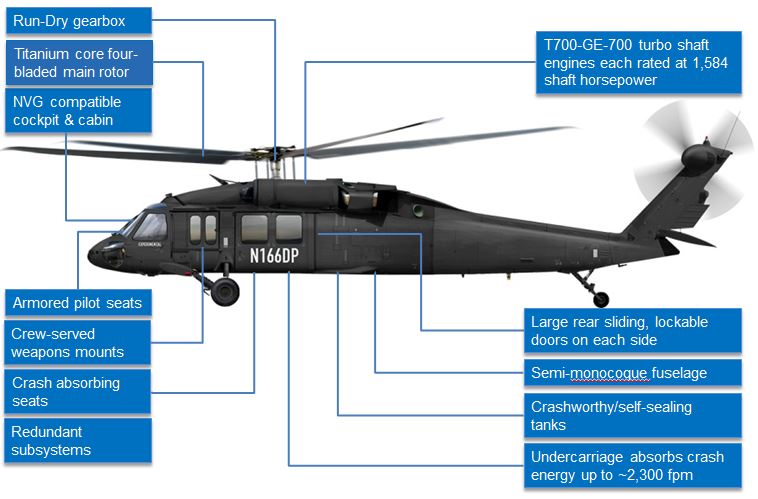Professional Insights: Enhancing Performance in UH 60 Helicopter Procedures
Professional Insights: Enhancing Performance in UH 60 Helicopter Procedures
Blog Article
Recognizing the Mechanics and Engineering Behind Uh 60 Helicopters
The UH-60 helicopter, commonly understood as the Black Hawk, stands as a peak of modern rotorcraft technology, personifying a blend of robust engineering and intricate technicians. From its creation to its present models, the evolution of this airplane showcases a blend of innovation and functionality. As we peel off back the layers of the UH-60's design, a world of elaborate systems and thorough engineering emerges. Recognizing the technicians and engineering behind this versatile aircraft reveals a world where accuracy fulfills power, and where each component plays a critical role in achieving flight.
Background of UH-60 Helicopters
The background of UH-60 helicopters traces back to the late 1970s when the United States Military looked for a functional and advanced utility helicopter to replace its aging fleet. In reaction to this requirement, the Sikorsky Aircraft Corporation developed the UH-60 Black Hawk helicopter. Presented in 1979, the UH-60 swiftly ended up being a staple in armed forces operations due to its outstanding abilities.
The UH-60 was created to stand out in a range of objectives, including army transportation, medical evacuation, digital war, and special operations. Its ability to adjust to various functions made it an important possession to the united state Army and other army pressures worldwide
Over the years, the UH-60 system has actually gone through a number of upgrades and variations to enhance its efficiency and maintain speed with progressing mission demands. These helicopters have seen considerable service in problems such as the Gulf War, Afghanistan, and Iraq, showcasing their integrity and flexibility in varied operational settings. The UH-60's rich history is a testimony to its enduring tradition as a premier utility helicopter.

Engine and Power Systems
Utilizing advanced propulsion technology, UH-60 helicopters are equipped with innovative engine and power systems to make certain optimum performance and reliability in a variety of functional situations. The UH-60, frequently understood as the Black Hawk, is powered by two General Electric T700-GE-701D engines, each qualified of supplying up to 1,940 shaft horse power. These turboshaft engines offer the required drive for the helicopter to execute its goals properly, consisting of army transport, medical evacuation, and fight assistance.

Rotor System and Aerodynamics
How do the blades system and the rules of aerodynamics of UH-60 helicopters add to their functional performance and trip abilities? The rotor system of the UH-60 helicopter plays a vital duty in supplying lift and propulsion. The UH-60 includes a four-bladed, completely verbalized rotor system that permits high maneuverability and security during flight. This design makes it possible for the helicopter to carry out a vast array of missions, from transportation and clinical evacuation to combat operations.
The rules of aerodynamics likewise play an essential role in the efficiency of UH-60 helicopters. The streamlined body and blades blade design reduce drag, permitting the helicopter to accomplish higher rates and much better fuel performance. The aerodynamic design of the UH-60 additionally adds to its ability to run in varied environmental problems, including high elevations and warm temperatures.
Avionics and Trip Control Systems

In its elaborate sychronisation with the blades system and aerodynamics of UH-60 helicopters, the avionics and flight control systems develop an essential network of innovations forming the airplane's operational capabilities. In the UH-60, these systems include digital display screens, communication radios, General practitioner navigation, climate radar, and autopilot systems.
The flight control systems of the UH-60 are accountable for converting the pilot's inputs right into the ideal adjustments to the rotor system, making sure secure trip and ability to move. These systems contain hydraulic actuators, servos, and computer systems that collaborate to control the tail and main blades, as well as other flight control surfaces. By precisely managing the helicopter's flight dynamics, these systems make it possible for pilots to perform a large range of missions, from transport and hop over to here search-and-rescue to combat procedures, with accuracy and self-confidence.
Duty and Applications in Air Travel
Avionics systems in UH-60 helicopters encompass a variety of electronic systems that aid in navigating, communication, surveillance, and controlling numerous aircraft functions. These systems consist of digital screens, auto-pilot systems, communication radios, General practitioner navigating devices, and weather radar. In addition, these systems incorporate safety and Source security features such as autopilot settings, surface awareness alerting systems, and security augmentation systems to improve the total safety and operational capacities of the UH-60 helicopters in various objectives, consisting of army transportation, clinical evacuation, search and rescue, and aerial firefighting.
Final Thought
Finally, the UH-60 helicopter is a versatile aircraft with an abundant background and progressed design. Its engine and power systems, rotor system, aerodynamics, avionics, and trip control systems all interact to make it a reliable and efficient equipment. The UH-60's role and applications in aviation are large, ranging from armed forces procedures to browse and save goals. Its proceeded growth and usage show its relevance in the area of aeronautics (uh 60).
In over here its detailed control with the blades system and the rules of aerodynamics of UH-60 helicopters, the avionics and trip control systems create an essential network of technologies shaping the aircraft's functional capacities.The trip control systems of the UH-60 are accountable for translating the pilot's inputs into the appropriate modifications to the rotor system, ensuring stable trip and ability to move. Avionics systems in UH-60 helicopters encompass an array of digital systems that help in navigating, communication, monitoring, and regulating different aircraft features. In addition, these systems integrate safety attributes such as auto-pilot modes, surface understanding cautioning systems, and security enhancement systems to enhance the total security and operational capacities of the UH-60 helicopters in different missions, consisting of troop transportation, medical discharge, search and rescue, and aerial firefighting.
Its engine and power systems, rotor system, the rules of aerodynamics, avionics, and flight control systems all function together to make it a dependable and reliable maker.
Report this page